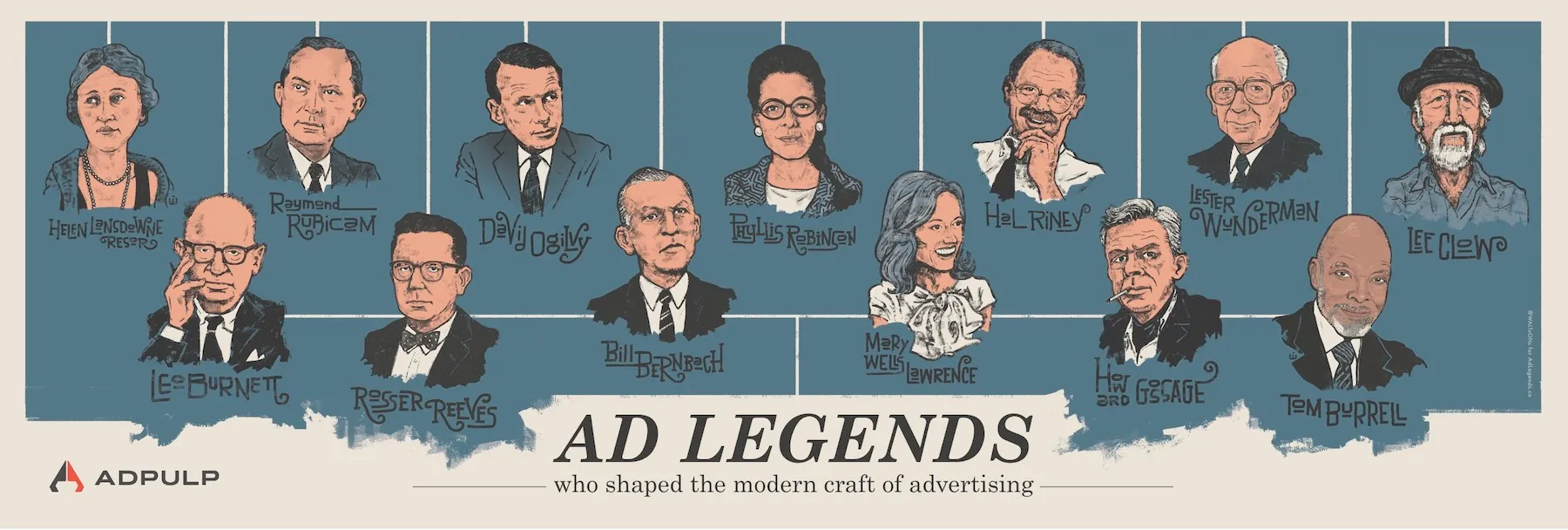TikTok challenges, retargeting ads, GDPR, crypto, and cookies? Is this the advertising business that we inhabit today? It feels foreign and disorienting. It’s not that the pace of change is too great. It’s that we refuse to pause and assess the value of the shiny new digital objects. At the same time, the fundamentals of the business are absent in way too many instances today, and to be successful as a marketer, they must never be absent. Clients spend millions of dollars with agencies to grow their audiences and ultimately generate more sales. To help them achieve their ends, we must know and practice the fundamentals, speak the same industry language, and agree upon what success looks like.
Learn from the Best, Learn from the Legends
My desire to fill the knowledge gap for advertising students and working professionals led me to research the careers of legendary advertising professionals. Ultimately, I chose 13 individuals to focus on. Identifying their signature achievements, then stepping back to see the relationships between their thinking and doing, has helped me immensely in my own ad industry journey. I hope that the information I’ve gathered here also helps you with yours.
Helen Lansdowne Resor
Helen Lansdowne Resor introduced sex appeal to advertising along with ads that spoke directly to women. She also placed an emphasis on art direction and hiring fine artists to help make ads. Lansdowne Resor hired many women in executive positions and she helped run the largest ad agency in the U.S. for several decades.
Leo Burnett
Leo Burnett worked as a reporter in Peoria, Il before joining GM, where he edited a publication for Cadillac dealers called Cadillac Clearing House. He eventually left GM to join Homer McKee, an agency in Indianapolis. On August 5, 1935, during the depths of The Great Depression, Leo Burnett (who was 42 years old at the time) opened the Leo Burnett Company in Chicago. The agency started with eight creatives and $12,000, which Burnett raised by selling his house and hocking his insurance policies. He and his agency went on to elevate brand storytelling to an unforeseen height, creating beloved brand characters for packaged goods brands like The Jolly Green Giant, Charlie the Tuna, and Tony the Tiger.
Raymond Rubicam
Raymond Rubicam was an innovative and persuasive man. He decided at the birth of Young & Rubicam that the writer, art director, researcher, merchandiser, and production expert would all be equal to the account executive. Y&R was also the first ad agency to adopt profit-sharing, the first to use comic strips as a medium for advertising, the first to use scientific telephone sampling, and the first to test audiences to measure the success of commercials and advertisements.
Rosser Reeves
Rosser Reeves invented the Unique Selling Proposition (USP), and advanced “Reason Why” advertising. His “Melts in your mouth, not in your hands” campaign for M&M’s is the perfect expression of these frameworks at work. Reeves helped elect President Eisenhower twice, and in 1961 published a best-selling book, Reality In Advertising.
David Ogilvy
David Ogilvy is one of the towering legends of the ad business. He invented the Hathaway Man for Hathaway Shirts and Commander Edward Whitehead for Schweppe’s—two brand characters that humanized the companies and made them more interesting than they might otherwise be. Ogilvy wrote the bestselling Confessions of an Advertising Man, and then followed it up with Ogilvy on Advertising. Both books continue to be widely read by students and practitioners today and are considered classics.
Bill Bernbach
Bill Bernbach lead the 1960s Creative Revolution and changed the way advertising was made. He is credited with inventing and promoting the copywriter-art director team…a huge step forward for the agency business. He also hired the most talented (and overlooked) people of his day: Phyllis Robinson was copy chief, Helmut Krone, and George Lois were art directors. DDB left room for the reader in their ads. It wasn’t all spelled out, and that triggered something positive in people.
Phyllis Robinson
There’s no ‘R’ in DDB, but there may as well be—that how critical Phyllis Robinson’s contribution to the agency was. Robinson was an intelligent writer and an excellent discoverer and nurturer of emerging talent. Ad legend, Mary Wells Lawrence, was one of her many recruits who, like Robinson herself, went on to the Copywriters Hall of Fame.
Mary Wells Lawrence
Mary Wells Lawrence is an advertising icon and shining star. Her “Striptease” campaign for Braniff Airlines resurrected the ailing company. She made many famous ads and her lines continue to resonate in today’s culture. “Flick your Bic” is Mary. “Trust the Midas Touch” is Mary. “I love NY” is Mary. So is, “I can’t believe I ate the whole thing.” She was the youngest person ever inducted into the Copywriters Hall of Fame at the age of 40.
Hal Riney
Hal Riney was a journalist who became an art director. His ability to tell captivating stories helped elect Ronald Reagan, introduce GM’s new Saturn line, and convince Americans that Bartes & James were real people and that their wine coolers were good drinking.
Howard Luck Gossage
Howard Luck Gossage was an interesting man with a small but mighty ad agency in a converted San Francisco firehouse. He was friends with Buckminster Fuller, Tom Wolfe, and other big thinkers. His agency’s work helped to save The Grand Canyon from flooding. Unique among his contemporaries, Gossage saw the benefit of integrating PR into his client’s communications plans. The ads he wrote were usually just the starting point for a campaign message that would then be amplified by the press, television and radio, and any number of different media. He called it his ‘ad platform technique’.
Lester Wunderman
Lester Wunderman was known as the father of direct marketing. In 1958—his new agency’s first year of existence)—Wunderman was responsible for the research, business development plan, and launching of the American Express Card. he instinctively knew how to reach people and how to move them. Like ad legends David Ogilvy and Rosser Reeves, Wunderman believed in sales first and foremost and he found new and innovative ways to use brand communications to deliver them at scale.
Tom Burrell
Tom Burrell was the first black person to work in the advertising agency business in the city of Chicago. His first job was in the mailroom at Wade Advertising. He wore a suit to work every day because he wanted to signal that he belonged at the agency but not in the mailroom. It worked. He became a copywriter at Wade, before moving on to Leo Burnett, Foote, Cone & Belding, and Needham, Harper & Steers. He launched Burrell McBain Advertising in 1971. Burrell then got to work injecting “Positive Realism” into the culture, and with the support of Coca-Cola and McDonald’s, his agency successfully pushed other more harmful images and narratives about black people out of the frame.
Lee Clow
Lee Clow brought a critical new “cool factor” to advertising. He proved that a surfer dude could achieve at the highest levels. For Clow, ad campaigns are not just a means to the client’s end. Advertising is an end in itself and a welcome part of popular culture. It was this thinking and his close partnership with Steve Jobs that made Apple’s “Think Different” campaign and “1984” Superbowl spot possible and memorable.

